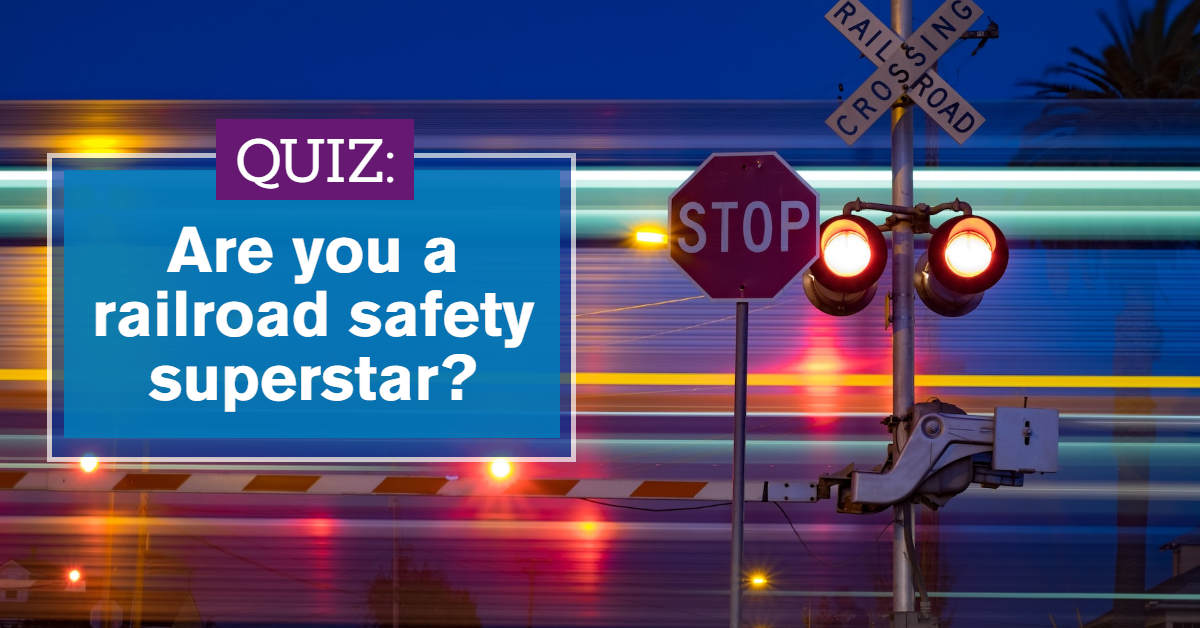Since 2017, Operation Life Saver’s Rail Safety Week has helped educate and empower the public to make safe decisions around trains and tracks. It’s important work, since every three hours a collision between a person or vehicle and a train occurs on railroad tracks in the United States. The good news is many of these tragedies are preventable, which is why it’s critical to know the facts about rail safety.
This year’s Rail Safety Week is September 19-25 but staying vigilant about rail safety should happen every day of the year. Take this quiz to test your knowledge and learn more about protecting yourself and others around train tracks.
RAIL CROSSING SAFETY QUIZ
Check Your Results and Get the Facts
- It's okay to cross railroad tracks anywhere as long as a train isn't present.
FALSE
Designated crossings are the only safe (and legal) place to cross. It’s important to cross train tracks ONLY at designated pedestrian or roadway crossings and obey all warning signs and signals posted there.
- Railroad tracks and the area around them are private property.
TRUE
All train tracks are private property, so pedestrians should never walk on or near them. Walking on train tracks may seem like fun, but it’s actually very dangerous, not to mention illegal.
- Trains pass through a crossing at the same time every day.
FALSE
Freight trains don't travel at fixed times, and schedules for passenger trains often change. That means a train can pass at any time, so always expect a train.
- Trains only travel in one direction on railroad tracks.
FALSE
Tracks aren’t one way, so even if you’ve seen a train traveling east, a train could travel west on the very same track. It’s also important to keep in mind that locomotives can both push and pull rail cars, so the location of the locomotive isn’t always an indicator of which direction the train is traveling.
- Trains are quieter and move faster than you think.
TRUE
An optical illusion makes it hard to determine how far away a train is and how fast it’s traveling. At the same time, trains are quieter than ever. For these reasons, trains are always closer and moving faster than you think.
- It’s okay to stand or walk near railroad tracks.
FALSE
Trains are wider than the tracks, so it’s not safe to stand or walk next to them. In fact, a train can extend three or more feet on either side of the steel rail, so the safe zone for pedestrians is well beyond three feet on either side. Vehicles stopped at a designated crossing should remain 15 feet or more from the tracks.
- A fire truck or ambulance has the right of way over a train.
FALSE
Trains always have the right of way. Even in the presence of emergency vehicles, the police or pedestrians, moving trains have the right of way. That includes cars, too.
- It's okay to take photos on or near railroad tracks if you do it quickly.
FALSE
It is never safe to walk, sit or stand on or near train tracks. The tracks and the area around them are private property, which means it’s also illegal and you’re trespassing.
- It takes the average freight train traveling at 55 mph more than a mile to stop.
TRUE
It takes a train traveling at 55 mph more than a mile to stop. That’s the length of 18 football fields. Trains cannot stop quickly enough to avoid a collision, which is why vehicles should never drive around lowered gates or try to “beat” a train. If you think a train can see you and stop in time, think again.
- An average locomotive weighs 200 tons, so a collision with a train can be deadly.
TRUE
The average locomotive weighs about 200 tons (400,000 pounds). That means when a train collides with a car, it’s similar to a car running over an aluminum can.
Learn More
To learn more about rail safety, consult Operation Lifesaver’s safety tips for drivers and pedestrians. Or, check out the National Highway Traffic Safety Administration’s (NHTSA) “7 Steps for Navigating Freight and Commuter Train Crossings.” To see Union Pacific’s safety resources, visit our Safety page.
To learn more about shipping by rail, subscribe or answer a few questions about your shipments and an expert will be in touch.
Related Articles
- 11 Train Facts that Could Save Your Life
- Railroad Tech: Rail Safety, Security and Visibility Innovations
- What Can a Railroad Build?
- Railroad History: How the Rail Industry Has Evolved in 160 Years
- Rail Shipper Tips: How to Prevent Train Derailments on Privately Owned Tracks
- Railroad Safety: Train Horns and Grade Crossing Signals
- How Do Railroads Keep Cross-Border Shipments Safe?
- Transportation Modes Revealed: Rail
- Rail 101 FAQs
- 12 Train Facts You Might Not Know
- U.S. Freight Rail: The Envy of the World
- How Much Freight Ships by Rail In the US?
- Quiz: Can Your Product Ship by Rail?









